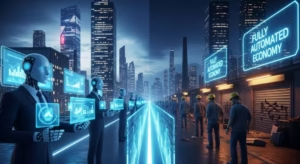AI and Global Inequality: Will Automation Widen the Wealth Gap?

The blog post titled ‘AI and Global Inequality: Will Automation Widen the Wealth Gap?’ explores the complex relationship between AI and inequality in today’s economy. It delves into how labor automation could potentially exacerbate economic disparities, particularly affecting lower-income individuals and marginalized communities. The article also highlights the digital divide, emphasizing its socioeconomic implications and how unequal access to technology can hinder overall progress. To address these challenges, the post proposes actionable strategies aimed at combating tech inequality, advocating for inclusive policies that promote equitable access to AI resources. By understanding AI and inequality, the conversation can shift towards creating a more balanced economic landscape in the age of automation.
Understanding AI And Inequality In The Modern Economy

The intersection of AI and inequality is a formidable issue that has come to the forefront of discussions surrounding economic disruption. As AI technologies advance, they hold the potential to transform industries; however, this transformation often results in an uneven distribution of benefits. The convergence of automation and economic prosperity typically favors those already in advantageous positions, exacerbating wealth disparities across societies. Professions that are more susceptible to automation often belong to lower-income brackets, leading to job displacement and widening the economic gap.
Key Aspects Of AI And Inequality:
- The potential for job displacement in lower-skill sectors.
- Concentration of wealth among technology firms and their stakeholders.
- Increased educational demands for higher-income job markets.
- The role of government policies in regulating AI deployment.
- Impact on regional economic development and disparities.
- Globalization of AI services leading to unequal access.
- The necessity for reskilling initiatives aimed at affected workers.
Understanding these components is crucial for addressing the broader implications of AI and inequality. It raises critical questions about the future of labor, economic mobility, and equitable growth. Policymakers and industry leaders must recognize the socioeconomic challenges posed by economic disruption. Establishing frameworks that promote inclusive growth will be essential to mitigate the adverse effects of automation on vulnerable populations.
The Impact Of Labor Automation On Economic Disparity

Labor automation has become a critical topic in discussions surrounding AI and inequality. As technology continues to advance, one of the primary concerns is how automation impacts job availability and income distribution. With the rise of AI-driven machinery and software, many low-skilled jobs are at risk of being replaced, leading to significant economic disparity. The fear is that as labor automation increases, the wealth gap will widen, leaving behind a significant portion of the workforce that lacks the necessary skills to adapt.
| Sector | Job Displacement Rate (%) | Average Salary Loss (%) |
|---|---|---|
| Manufacturing | 40 | 25 |
| Customer Service | 30 | 20 |
| Transport & Logistics | 35 | 15 |
| Retail | 25 | 10 |
While labor automation presents efficiency improvements and cost reductions for businesses, it also poses challenges for workers, particularly those in industries that are heavily reliant on manual labor. This shift is not only about job displacement; it also highlights the broader implications of tech inequality. Individuals who can adapt to new technologies often find new opportunities, whereas those unable to transition may find themselves struggling to make ends meet. As such, the consequences of labor automation extend beyond individual job loss to factors that can exacerbate systemic socioeconomic disparities.
Steps To Analyze Labor Automation Effects:
- Assess the sectors most affected by automation.
- Evaluate job displacement rates across different industries.
- Examine changes in average salaries and employment rates.
- Identify the demographic groups disproportionately impacted.
- Consider long-term implications of skill gaps in the workforce.
- Investigate opportunities for retraining and upskilling.
- Formulate policies to mitigate the negative effects of automation.
Analyzing Job Displacement
The dynamics of labor automation necessitate a deeper understanding of job displacement trends across various sectors. It is crucial to recognize which industries face the most risk and how this correlates with workforce demographics. For example, low-skilled jobs, commonly held by marginalized groups, are more susceptible to being automated. This highlights a critical area of tech inequality that needs addressing in order to ensure a fairer economic landscape.
Future Skill Requirements
As the labor market evolves, so too must the skill sets of the workforce. Jobs that remain less susceptible to automation tend to require advanced technical skills or creative problem-solving abilities. Thus, there is an urgent need for educational institutions and organizations to innovate training programs that equip workers with skills pertinent to the future economy. Strong emphasis on STEM education, alongside soft skills training, is essential for bridging the gap created by labor automation and ensuring a more equitable workforce.
Examining The Digital Divide And Its Socioeconomic Implications

The digital divide is a pressing issue that highlights the disparities in access to technology and the internet, which ultimately exacerbates existing socioeconomic inequalities. As AI and inequality become increasingly intertwined, we must recognize that economic disruption driven by automation may further widen the gap between diverse populations. Those without adequate access to digital resources face not only limitations in education and job opportunities but also a growing disconnect from essential services increasingly delivered online.
Consequences Of The Digital Divide:
- Lack of access to quality education resources.
- Limited job opportunities and workforce participation.
- Inability to access telehealth services, compounding health disparities.
- Reduced economic mobility for low-income families.
- Increased social isolation and undervaluation of marginalized communities.
- Wider gaps in digital literacy skills across different socioeconomic groups.
- Challenges in civic engagement and participation in democratic processes.
As we address the implications of the digital divide, it becomes evident that those on the wrong side of this gap will face profound challenges in adapting to a rapidly changing economic landscape. With the rise of AI technologies, many workers may find themselves unable to compete effectively in the job market, leading to further economic disparity. The socially vulnerable populations are at higher risk of being left behind, facing barriers that delay their progress and perpetuate cycles of poverty.
Addressing Digital Access Gaps
To foster greater equity, it is crucial to implement comprehensive strategies aimed at bridging the digital divide. Public and private sector collaboration is essential, focusing on expanding broadband access, improving digital literacy, and providing affordable technology to underserved communities. By addressing these access gaps, we can mitigate the risk of economic disruption caused by automation and ensure that all individuals have the opportunity to fully participate in the digital economy.
Confronting Tech Inequality With Actionable Strategies

Addressing tech inequality requires a multifaceted approach that not only recognizes the disparities caused by advancements in technology but also actively works towards solutions. The advent of AI has the potential to further widen the wealth gap, as those with access to technology can leverage AI-driven efficiencies while others may be left behind. It is crucial to develop and implement actionable strategies aimed at leveling the playing field, thereby ensuring that the benefits of technology can be equitably shared across society.
Strategies To Mitigate Tech Inequality:
- Invest in education and training programs to upskill workers for AI-related jobs.
- Promote digital literacy initiatives to ensure all demographics can access technology.
- Encourage policy reforms that support fair wages and labor protections in tech-driven economies.
- Implement community-based tech access programs to bridge the digital divide.
- Foster collaboration between public and private sectors to create inclusive tech ecosystems.
- Support businesses that prioritize social responsibility and equitable practices.
Each of these strategies can play a pivotal role in addressing the challenges posed by AI and inequality. It is imperative that we not only recognize the issue at hand but also take concrete steps to mitigate the impact that automation may have on vulnerable populations. Through at least some of these actionable strategies, we can work towards a more equitable technological future, ensuring that everyone has the opportunity to benefit from AI advancements.
Briefing Document: AI and Global Inequality
Key Themes and Most Important Ideas/Facts:
1. AI as a Driver of Economic Disparity: The core argument is that AI technologies, while transformative, are likely to lead to an “uneven distribution of benefits.” The “convergence of automation and economic prosperity typically favors those already in advantageous positions, exacerbating wealth disparities across societies.”
- Job Displacement in Lower-Skill Sectors: Professions in lower-income brackets are “more susceptible to automation,” leading to significant job loss. The source provides a table illustrating potential job displacement rates and average salary loss in sectors like Manufacturing (40% displacement, 25% salary loss), Customer Service (30% displacement, 20% salary loss), Transport & Logistics (35% displacement, 15% salary loss), and Retail (25% displacement, 10% salary loss).
- Wealth Concentration: AI advancements can lead to “concentration of wealth among technology firms and their stakeholders.”
- Increased Educational Demands: Higher-income job markets require “increased educational demands,” creating a barrier for those without access to advanced training.
- Impact on Regional Development: The globalization of AI services can lead to “unequal access” and exacerbate “regional economic development and disparities.”
2. The Impact of Labor Automation on Economic Disparity: Labor automation is identified as a primary concern, directly contributing to widening the wealth gap. The fear is that as automation increases, “a significant portion of the workforce that lacks the necessary skills to adapt” will be left behind.
- Systemic Socioeconomic Disparities: The consequences of labor automation extend beyond individual job loss, exacerbating “systemic socioeconomic disparities.”
- Vulnerability of Marginalized Groups: “Low-skilled jobs, commonly held by marginalized groups, are more susceptible to being automated. This highlights a critical area of tech inequality that needs addressing…”
- Urgent Need for Reskilling: There is an “urgent need for educational institutions and organizations to innovate training programs that equip workers with skills pertinent to the future economy.” This includes a “strong emphasis on STEM education, alongside soft skills training.”
3. The Digital Divide and its Socioeconomic Implications: The digital divide is presented as a “pressing issue” that directly “exacerbates existing socioeconomic inequalities.” Lack of access to technology and the internet creates a significant barrier to opportunities and essential services.
- Consequences of the Digital Divide: These include “lack of access to quality education resources,” “limited job opportunities and workforce participation,” “inability to access telehealth services,” “reduced economic mobility for low-income families,” and “increased social isolation and undervaluation of marginalized communities.”
- Vulnerability of Socially Vulnerable Populations: “The socially vulnerable populations are at higher risk of being left behind, facing barriers that delay their progress and perpetuate cycles of poverty.”
4. Actionable Strategies to Confront Tech Inequality: The source advocates for a “multifaceted approach” to mitigate the negative impacts of AI and ensure equitable benefits.
- Investment in Education and Training: “Invest in education and training programs to upskill workers for AI-related jobs.”
- Promotion of Digital Literacy: “Promote digital literacy initiatives to ensure all demographics can access technology.”
- Policy Reforms: “Encourage policy reforms that support fair wages and labor protections in tech-driven economies.”
- Community-Based Programs: “Implement community-based tech access programs to bridge the digital divide.”
- Public-Private Collaboration: “Foster collaboration between public and private sectors to create inclusive tech ecosystems.”
- Support for Socially Responsible Businesses: “Support businesses that prioritize social responsibility and equitable practices.”
Conclusion: The source stresses that understanding the interplay between AI and inequality is crucial for shifting the conversation towards “creating a more balanced economic landscape in the age of automation.” It emphasizes the need for policymakers and industry leaders to proactively establish frameworks that promote inclusive growth to mitigate the adverse effects of automation on vulnerable populations.
Homepage / humanaifuture.com
For similar articles, please visit: AI and Society
🎧 Listen to the Podcast
Want to explore this topic in more depth? Listen to the full podcast for more insights and expert commentary.
▶️ Play on Google DriveNo sign-up needed — just click and listen.
Which sectors are most susceptible to job displacement due to AI automation?
Sectors heavily reliant on manual or repetitive labor are most susceptible to job displacement. According to the provided source, manufacturing (40% displacement rate), customer service (30%), transport & logistics (35%), and retail (25%) are particularly at risk. These job losses disproportionately affect lower-income individuals and marginalized communities who often hold these positions.
What is the "digital divide" and how does it relate to AI and inequality?
The "digital divide" refers to the unequal access to technology and the internet. In the context of AI and inequality, it signifies that individuals and communities lacking digital resources face significant limitations. This includes restricted access to quality education, limited job opportunities, and an inability to access essential online services. As AI technologies advance and become more integrated into the economy, those on the wrong side of the digital divide are further disadvantaged, struggling to compete in the evolving job market and facing increased economic disparity.
What are the key consequences of the digital divide?
The consequences of the digital divide are far-reaching and include: lack of access to quality education resources, limited job opportunities, inability to access telehealth services, reduced economic mobility for low-income families, increased social isolation and undervaluation of marginalized communities, wider gaps in digital literacy skills, and challenges in civic engagement. These consequences collectively perpetuate cycles of poverty and hinder overall progress for vulnerable populations.
What new skill requirements are emerging as a result of labor automation?
As labor automation advances, the demand for traditional manual labor decreases, while the need for new skills increases. Jobs that are less susceptible to automation typically require advanced technical skills, creative problem-solving abilities, and strong soft skills. Therefore, there is an urgent need for educational institutions to innovate training programs that emphasize STEM education and soft skills training to equip workers for the future economy.
What are some actionable strategies to mitigate tech inequality?
Addressing tech inequality requires a multi-faceted approach. Key actionable strategies include: investing in education and training programs to upskill workers for AI-related jobs, promoting digital literacy initiatives across all demographics, encouraging policy reforms for fair wages and labor protections in tech-driven economies, implementing community-based tech access programs to bridge the digital divide, fostering collaboration between public and private sectors for inclusive tech ecosystems, and supporting businesses that prioritize social responsibility and equitable practices.
How can policymakers and industry leaders contribute to a more balanced economic landscape in the age of automation?
Policymakers and industry leaders must recognize the socioeconomic challenges posed by economic disruption due to AI. They need to establish frameworks that promote inclusive growth to mitigate the adverse effects of automation on vulnerable populations. This involves implementing policies that ensure equitable access to AI resources, supporting reskilling initiatives for affected workers, and fostering collaboration to bridge the digital divide and create a fairer economic landscape.
Why is it crucial to address the issue of AI and inequality now?
It is crucial to address the issue of AI and inequality now because the rapid advancement of AI technologies holds the potential to significantly widen the wealth gap and exacerbate existing socioeconomic disparities. Without proactive measures, the benefits of AI may be unevenly distributed, leaving lower-income individuals and marginalized communities further behind. Understanding these components is essential to shift the conversation towards creating a more balanced and equitable economic landscape in the age of automation.




